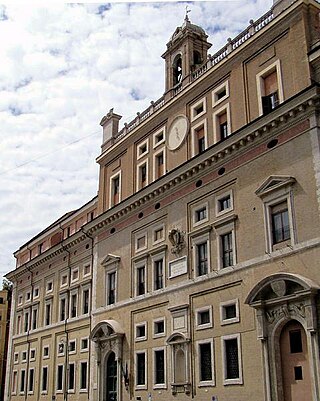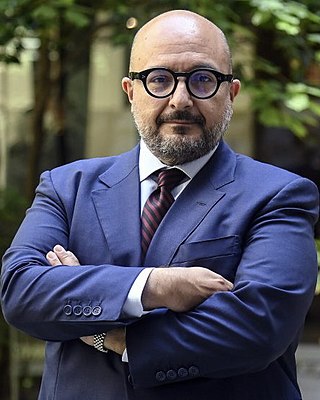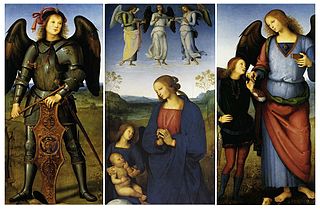
The Accademia di Belle Arti di Firenze is an instructional art academy in Florence, in Tuscany, in central Italy.

The Palazzo Pitti, in English sometimes called the Pitti Palace, is a vast, mainly Renaissance, palace in Florence, Italy. It is situated on the south side of the River Arno, a short distance from the Ponte Vecchio. The core of the present palazzo dates from 1458 and was originally the town residence of Luca Pitti, an ambitious Florentine banker.

The Certosa di Pavia is a monastery and complex in Lombardy, Northern Italy, situated near a small town of the same name in the Province of Pavia, 8 km (5.0 mi) north of Pavia. Built in 1396–1495, it was once located on the border of a large hunting park belonging to the Visconti family of Milan, of which today only scattered parts remain. It is one of the largest monasteries in Italy.

The Biblioteca Nazionale Vittorio Emanuele III is a national library of Italy. It occupies the eastern wing of the 18th-century Palazzo Reale in Naples, at 1 Piazza del Plebiscito, and has entrances from piazza Trieste e Trento. It is funded and organised by the Direzione Generale per i Beni Librari and the Ministero per i Beni e le Attività Culturali.

The Ministry of Culture is the ministry of the Government of Italy in charge of national museums and the monuments historiques. MiC's headquarters are located in the historic Collegio Romano Palace and the current Minister of Culture is Gennaro Sangiuliano.

Graziella "Lalla" Romano was an Italian novelist, poet, artist and journalist.

Santa Maria del Carmine is a church in Pavia, Lombardy, northern Italy, considered amongst the best examples of Lombard Gothic architecture. It was begun in 1374 by Gian Galeazzo Visconti, Duke of Milan, on a project attributed to Bernardo da Venezia. The construction followed a slow pace, and was restarted in 1432, being finished in 1461.

Brovinje Italian: Brovigne is a small settlement/hamlet, in Istria County in Croatia, with a little more than 50 houses in 1950. It is located in the Labinština peninsula of Istria County, Croatia. Overlooking the Gulf of Kvarner in the northern Adriatic Sea including the island of Croatian: Cres, Italian: Cherso. It is located 13 km south-east of Labin and 3 km north of Koromačno/Valmazzinghi. The first written record with the name Brovinje is recorded in the old St. Lucia church books on birth, marriages and deaths in 1705 which are held in Pazin, Istria. Brovinje is a hamlet which is under the Raša municipality.

The Carabinieri Command for the Protection of Cultural Heritage, better known as the Carabinieri T.P.C., is the branch of the Italian Carabinieri responsible for combatting art and antiquities crimes and is viewed as an experienced and efficient task force.
The Pergolesi Spontini Foundation was established in Jesi in 2000, by the Marche Region, the Province of Ancona, the Municipality of Jesi and the Municipality of Maiolati Spontini. The municipalities of Montecarotto, Monte San Vito, Monsano, San Marcello are associated members. The Chamber of Commerce of Ancona entered as Contributing Participant. A group of private companies supports the Foundation.
Tommaso Maria Conca (1734–1822), was an Italian painter and draftsman, active mostly in Rome.
The old farmhouses of Brugherio were agricultural structures typical of the Po-Valley in Lombardy, which gave its name to the surrounding areas as well, roughly corresponding to fractional towns in which Brugherio was divided. The union of the various small rural municipalities in which the territory was fragmented gave birth in 1866 to the municipality of Brugherio. Some are still visible: Bindellera, Casecca, Cattoni, Comolli, Dorderio, Guzzina, Increa, Modesta, Moia, Occhiate, Pareana, San Cristoforo, Sant'Ambrogio, San Paolo and Torazza.

Rodolfo Gambini was an Italian painter, active mainly in Milan, Lombardy, Piedmont, and Liguria. He painted both history and sacred subjects. He was born in Arluno and died in Alessandria, Piedmont. He studied at the Accademia di Belle Arti di Brera in Milan. Piero Vignoli and Giovanni Ferraboschi were two of his pupils.

Chiesa di Santa Maria in Valle Porclaneta is a Romanesque church in Rosciolo dei Marsi, in western Abruzzo, central Italy.

The minister of culture leads the Ministry of Culture. The list shows also the ministers that served under the same office but with other names, in fact this ministry has changed name many times.

The Villa di Marignolle is a Medici villa in the hills between Galluzzo and Soffiano, in the south-western suburbs of the comune of Florence, in Tuscany in central Italy. It passed into the hands of the Medici family after the Pucci Conspiracy, when it was confiscated from Lorenzo di Piero Ridolfi by Francesco I de' Medici, Grand Duke of Tuscany. Francesco passed it to his illegitimate son Antonio.

San Lanfranco is a Romanesque-style Catholic church and former abbey, located on via San Lanfranco Vescovo, 4/6, just west of the town center of Pavia, region of Lombardy, Italy.

The Certosa di Pavia Altarpiece was an oil on panel altarpiece by Pietro Perugino. It dates to around 1496 to 1500 and three of its panels are now in the National Gallery, London. Art historians believe that the central panel is an autograph copy of the Madonna del Sacco.

The monastery of Santa Maria Teodote, also known as Santa Maria della Pusterla, was one of the oldest and most important female monasteries in Pavia, Lombardy, now Italy. Founded in the seventh century, it stood in the place where the diocesan seminary is located and was suppressed in the eighteenth century.
















